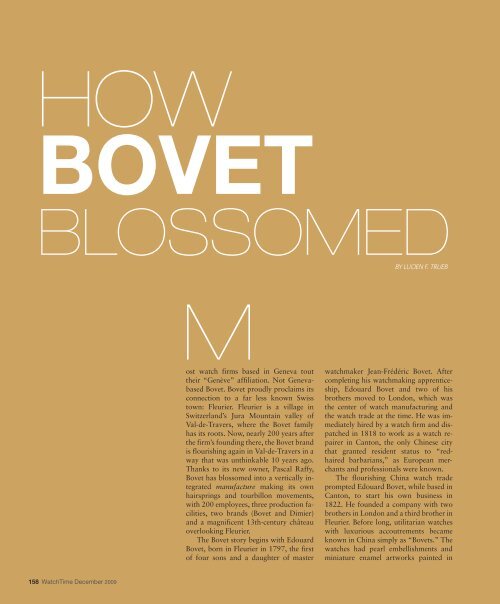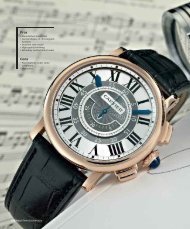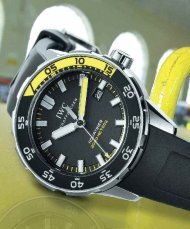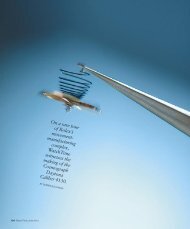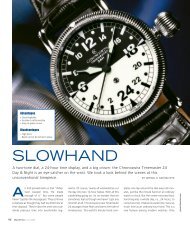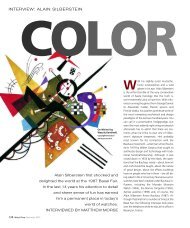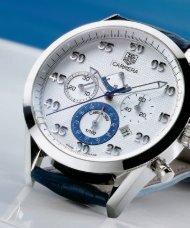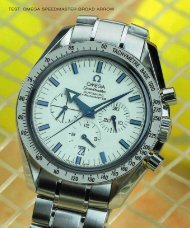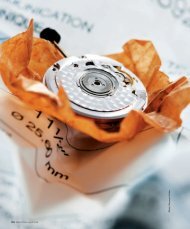WT_2009_06: PROFILE: BOVET FLEURIER
WT_2009_06: PROFILE: BOVET FLEURIER
WT_2009_06: PROFILE: BOVET FLEURIER
You also want an ePaper? Increase the reach of your titles
YUMPU automatically turns print PDFs into web optimized ePapers that Google loves.
HOW<strong>BOVET</strong>BLOSSOMEDBY LUCIEN F. TRUEBMost watch firms based in Geneva touttheir “Genève” affiliation. Not GenevabasedBovet. Bovet proudly proclaims itsconnection to a far less known Swisstown: Fleurier. Fleurier is a village inSwitzerland’s Jura Mountain valley ofVal-de-Travers, where the Bovet familyhas its roots. Now, nearly 200 years afterthe firm’s founding there, the Bovet brandis flourishing again in Val-de-Travers in away that was unthinkable 10 years ago.Thanks to its new owner, Pascal Raffy,Bovet has blossomed into a vertically integratedmanufacture making its ownhairsprings and tourbillon movements,with 200 employees, three production facilities,two brands (Bovet and Dimier)and a magnificent 13th-century châteauoverlooking Fleurier.The Bovet story begins with EdouardBovet, born in Fleurier in 1797, the firstof four sons and a daughter of masterwatchmaker Jean-Frédéric Bovet. Aftercompleting his watchmaking apprenticeship,Edouard Bovet and two of hisbrothers moved to London, which wasthe center of watch manufacturing andthe watch trade at the time. He was immediatelyhired by a watch firm and dispatchedin 1818 to work as a watch repairerin Canton, the only Chinese citythat granted resident status to “redhairedbarbarians,” as European merchantsand professionals were known.The flourishing China watch tradeprompted Edouard Bovet, while based inCanton, to start his own business in1822. He founded a company with twobrothers in London and a third brother inFleurier. Before long, utilitarian watcheswith luxurious accoutrements becameknown in China simply as “Bovets.” Thewatches had pearl embellishments andminiature enamel artworks painted in158 WatchTime December <strong>2009</strong>
The 187-year-old Bovet brand has undergonea remarkable revival thanks to one man whofell madly in love with it.Bovet SportsterSaguaro limitededitionchronographswith (l-r) steel (100pieces), rose-gold (50pieces) and black PVDsteel (100 pieces) caseswith meteorite dials
<strong>PROFILE</strong>Bovet FleurierGeneva that appealed to cultivated Chinese.Unlike the extremely luxuriouswatches of their era, Bovet timepieceswere affordable for upper-class Chinesecivil servants and merchants.The watches’ movements, often finelyengraved and chased, could be viewedthrough panes of glass in the casebacks.Their central seconds hands, which advancedby one leap per second, were anotherspecial feature. Bovet adapted hisproduction to suit the Chinese custom ofgiving valuable gifts (such as statues, vases,horses or even concubines) in pairs. Inthis way, he was frequently able to selltwo identical watches to the same purchaser.If one timepiece malfunctioned, aspare was on hand. This was most welcomebecause many months would passbefore a watch sent to Switzerland for repairmade its way back to China.Edouard Bovet returned to Fleurier ahero in 1830, accompanied by his fouryear-old,Macao-born son, Edouard-Georges. He was not there long becausehe immediately got caught up in localpolitics. Neuchâtel at that time was ruledby the King of Prussia and Bovet was partof a movement agitating for independence.When an attempted revolutionagainst Prussian sovereignty failed in December1831, Bovet fled to Besançon,France. There he continued to manufacturetimepieces with the help of other exiledwatchmakers. The lordly home inFleurier, which his brothers arranged tohave built for him according to his writteninstructions, remained empty at first;it serves as a community center today.Edouard’s brothers and nephews, allshareholders in the family business, tookcare that the pillars of the Bovet businessin Fleurier, London and Canton continuedto flourish. The firm was re-registeredin 1840 as “Bovet Frères et Cie” with ashare capital valued at one million francs.Edouard died in 1849, living long enoughto see the triumph of the Neuchâtel republicand the retreat of the Prussians in1848. There was an orderly transfer ofpower in the Bovet firm. Manufacturingcontinued in China. At the ExpositionUniverselle in Paris in 1855, the firm wona gold medal for an identical pair ofwatches ordered by the Chinese emperor.A sketch of the Jura Mountainvillage of Fleurier in the 19thcenturyFounderEdouard Bovet160 WatchTime December <strong>2009</strong>
Bovet’s Fleurier Tourbillon 7Days Jumping Hours watchfeatures the firm’s in-housetourbillon movement andfleurisanne decoration onthe bridges.Bovet owner and managingdirector Pascal RaffyIn the course of the next generation,the cosmopolitan Bovets lost interest inwatchmaking and sold the manufacturingfacility in Fleurier to its managers.The Bovet firm evolved into a tradingcompany that exported watches and otherSwiss products to China, and importedChinese silk and tea, primarily throughthe Bovet subsidiary in London. Finally,the business was sold for 100,000 goldfrancs to Leuba Frères at an auction inParis in 1901. It changed hands again in1918, and returned briefly to the Bovetfamily in the 1930s. It passed permanentlyout of family hands in 1948. Bovetwatch production halted in 1950 and thebrand became dormant.In 1997, the Bovet brand reappearedunder new owners, Roger Guye andThierry Oulevay. The new Bovet watcheswere well received. Particularly noteworthywas the “Fleurier” model: a smallpocket watch modified for the wrist, witha crown and a massive, stirrup-shapedbow at 12 o’clock for attaching the strap.Instead of conventional lugs at 6 o’clock,it had a hidden attachment that gavemaximum mobility to the band. Thispocket-watch-inspired geometry has distinguishedall Bovet watches ever since.Each Bovet, wristwatch as well as pocketwatch, has the instantly recognizable featureof the crown and bow at the 12o’clock position.THE MAJOR TURNING point for theBovet brand in the modern era came in2001 when the French-Lebanese businessmanPascal Raffy acquired the firmand began running it. Raffy was born to aFrench father and a Lebanese mother inBeirut in 1963. When the Lebanese civilwar erupted in 1976, Raffy’s family leftthe country. They initially settled inSwitzerland, and then moved to Paris,where an uncle lived, in 1978.December <strong>2009</strong> WatchTime 161
<strong>PROFILE</strong>Bovet FleurierRaffy attended secondary school inthe French capital, where he later studiedlaw. After earning his law degree, heworked in the pharmaceuticals industry.Eventually, his entrepreneurial spiritkicked in and he founded his own pharmaceuticallaboratory.He inherited a love of watches fromhis paternal grandfather, an enthusiasticwatch collector who shared his passionwith his young grandsons and grandnephews.At family gatherings on Sundayafternoons, he entertained the youngstersby putting his treasures through theirpaces and explaining complicated movements,beautiful enamel work and thetechniques of engraving, guilloché andgemstone setting. The seed planted by thegrandfather sprouted in Raffy in Paris,where he began collecting beautifulwatches.He ran his pharmaceutical businessfor 12 years, traveling more than 300days each year. When his nine-year-olddaughter lamented her father’s frequentabsences, he promised her that he wouldchange his workaholic ways and spendmore time at home. Shortly after that, hesold his business and took a two-year vacationto devote himself exclusively to hisfamily. But his banker knew that a dyedin-the-woolentrepreneur wouldn’t beThe Bovet workshop in theChateau de MôtiersEACH <strong>BOVET</strong> BRAND WATCHHAS THE DISTINCTIVEFEATURE OF THE CROWN ANDBOW AT 12 O’CLOCK.The Chateau de Môtiers, built in the 13th century,overlooks Fleurier and once belonged to theBovet family. Pascal Raffy bought it in 2007.content to retire at the age of 40, so hearranged a meeting between Raffy and aman with connections in the Swiss watchmakingindustry. The watch maven recommendedthat Raffy invest in that industry,but the young retiree initially refused.Soon after, however, Raffy laid his eyes forthe first time on a Bovet watch, which fascinatedand deeply moved him. He beganan intensive study of Bovet’s watches andhistory. He valued Bovet as a prestigebrand, which reflected his notion of genuineluxury as opposed to an apparentlyluxurious but mass-produced product.Raffy decided to purchase the firm,and has since elevated it to the highest levelof luxury. In keeping with Bovet tradition,20 percent of its production consistsof one-of-a-kind pieces created and/ordecorated according to customers’ requests.But the most striking thing aboutBovet today is how quickly Raffy has162 WatchTime December <strong>2009</strong>
The Dimier 1735 manufacturein Tramelan, SwitzerlandUnlike Bovet watches, Dimierwatches have the crown at 3o’clock. Bovet introduces oneDimier watch per year; the <strong>2009</strong>edition is the Orbis Mundi automatictourbillon world timer.turned the tiny company into a verticallyintegrated manufacturing group.MOST OF THE <strong>BOVET</strong> buildup hascome in the past five years. It began in2004, when Raffy took a 25 percentshare in Aubert Complications, in theVallée de Joux. Aubert makes a modulewith retrograde perpetual calendar exclusivelyfor Bovet, which mounts the moduleon Vaucher’s basic movement.Since 20<strong>06</strong>, Raffy has invested heavilyin developing Bovet’s manufacturingbase. In 20<strong>06</strong>, he purchased STT (SwissTiming Technology) Complications andSTT Mechanical Movements, makers oftourbillons and calibers. STT, locatedin the Jura Mountain town ofTramelan, was founded in 1999 asProgress Watch. It was taken overby a Dutch Group in 2003 andrenamed STT. STT was aBovet supplier; it producedits seven-day tourbillonand other tourbillonmovements. When STTfell on hard times,Raffy took it over. Hechristened it “Dimier1738.” (Dimierwas a prominentFleurier brand in the19th century; the“1738” was derivedfrom the birthdays ofRaffy’s children.) Raffy alsoacquired the Spirit hairspringsfactory affiliated with STT andincorporated it into Dimier inTramelan. There, he manufactureshairsprings with tolerances up to0.1-micrometers. Raffy did the sameThe Bovet 1822Group at a GlanceFOUNDED: 1822 by Edouard Bovetwith offices in Canton, Fleurier, andLondonOWNER: Pascal Raffy, since 2001HEADQUARTERS: Bovet Fleurier SA, 9rue Ami-Levrier, Geneva, Switzerland;eventual headquarters: Le Chateau,Môtiers, SwitzerlandSUBSIDIARIES: Hong Kong, Tokyo,MiamiEMPLOYEES: 200ANNUAL PRODUCTION: Fewer than2,000 watches per yearBRANDS: Bovet 1822 (two collections:Fleurier and Sportster, plus uniquecustom pieces) and Dimier limitededitionpiecesMANUFACTURING FACILITIES:• Dimier 1738 Manufacture de HauteHorlogerie Artisanale, Tramelan,Switzerland; 2,000 square meters, 76employees: research, design, developmentof watch movements, particularlycomplications• Dimier 1738 Manufacture de Cadranset de Sertissage, Plan-les-Ouates/Geneva, Switzerland; 900square meters, 38 employees: designand manufacture of dials and gemsetting• Dimier 1738, Le Chateau, Môtiers,Switzerland: watchmaking workshop,20 employees• Aubert Complications, 25% holding,1,000 square meters, 40 employees:production of complicated modulesDecember <strong>2009</strong> WatchTime 165
<strong>PROFILE</strong>Bovet Fleurierthing with Aigat SA, which specializesin precision embossing tools and sparkerosion for material removal. Today,more than 70 employees work at Dimier1738.Raffy also took an 81 percent interestin the dial-maker Valor & Lopez in 20<strong>06</strong>.The company, now called Dimier 1738Manufacture Artisanal de Cadrans et deSertissages, is located in Plan-les-Ouatesoutside Geneva and specializes in enamel,pavé, mother-of-pearl and manually guilloché-embellisheddials, as well as gemstonesetting.That same year, 20<strong>06</strong>, Raffy learnedthat the Château de Môtiers, which datesfrom the 13th century, was for sale. Thechâteau is located in Môtiers, next toFleurier, and stands atop a wooded hilloverlooking Fleurier. The appeal forRaffy was that it once belonged to theBovet family. He purchased it in 2007.After extensive renovations, it opened in2008 and houses a watchmaking workshopwith 20 employees. It will eventuallybecome the headquarters of the Bovetfirm. It marks the realization of Raffy’sdream to return Bovet to its roots in Valde-Travers.TODAY RAFFY’S <strong>BOVET</strong> 1822 Groupproduces 2,000 watches a year, ranging inprice from $12,500 to $900,000. Thecore brand is Bovet 1822, whichcomes in two collections,Fleurier and Sportster. Typicalof the Fleurier collectionof complicatedwatches is the newComplications 47 mm,a watch featuring twoof what Bovet calls its“star” complications,the tourbillon andjumping hour. It containsBovet’s ownself-winding, sevendaytourbillon movement(Caliber 13BA05made by Dimier). It hasa number of distinctiveBovet features: a tourbilloncage in the shape of a lotusblossom, the Bovet corporateemblem; serpentine handson the subdials; and the Fleurierstyledecoration (called fleurisanne) of engravedbridges. Bovet will produce 50pieces: prices are $195,000 for the rosegoldmodel and $199,000 for the whitegoldone. Bovet also creates one-of-a-kindpieces, with enamel dials, in the Fleuriercollection.The Sportster collection, as the nameimplies, is for Bovet’s sportier designs.New this year are Sportster Saguarochronographs with meteorite dials($19,800 to $39,500). Bovet also introduceda tourbillon into the Sportster linethis year. The Saguaro Tourbillon has an18k-rose-gold case with black PVD titaniuminserts on the side and a rubberstrap. The tourbillion movement is the inhouseCaliber 13BA05. The watch comesin three sizes: 40-, 45- and 51-mm, pricedfrom $140,000 to $151,000.In 2007, Raffy introduced a secondbrand called Dimier, consisting of highlycomplicated limited-edition pieces withthe crown in the traditional position at 3o’clock. The company introduces onenew Dimier piece a year under the nameThis minute repeater withmother-of-pearl dial and whitetiger painting is one of about400 one-of-a-kind pieces Bovetmanufactures per year.Bovet put its in-house tourbillon in the SportsterSaguaro collection for the first time this year.166 WatchTime December <strong>2009</strong>
THE BRAND OFTEN CREATESENAMEL-PAINTED DIALS INMIRROR-IMAGE PAIRS, ASIT DID IN ITS CHINESE PERIOD.Recital. The <strong>2009</strong> watch, Recital 3, is theOrbis Mundi, a mechanical self-windingtourbillon with seven-day power-reserveand world timer with 24 cities indicated.It’s priced at about $200,000 for rosegold and $210,000 for white gold.In developing products, Raffy relieson his own good taste. His collection consistsexclusively of watches that appeal tohim personally and that he would wearhimself. In addition to classical men’smodels with cases measuring 39, 42 or 44mm in diameter, Raffy developed Bovetchronographs with two or three countersand big date displays, plus a moon-phasedisplay and a hand-type calendar indicator.Other complications included a perpetualcalendar, a minute repeater, a tourbillonand a jumping hour.Some Bovet watches are equippedwith one of the world’s most beautifulmechanical movements: Piguet’s 12½ligneCaliber FP 71 with micro-rotor.Others contain automatic Caliber Vaucher331, made in the manufacture thatMichel Parmigiani established in Fleurier.(The old Vaucher firm had manufacturedfor the original Bovet brand in the 19thcentury.) Onto these calibers, Agenor inGeneva adds complication modules, likethose for jumping hours and perpetualcalendars. Christophe Claret of Le Locledelivers complicated movements withminute repetition and/or butterfly-shapedtourbillons. Bovet inverts Claret’s repeatermovement so that the tourbillonand the hammer that strikes the gongs areboth visible through the watch’s crystal.Many Bovet watches boast specialenamel painting, engraving and/or embellishmentwith gemstones or pearls. Theseemingly sober cases are free of superfluousfrills, yet they’re highly recognizablethanks to their pocket-watch geometry.Genuine pearls or diamonds serve ashour indices on some models. The tradi-tion of enameling (cloisonné or miniaturepainting) continues to be cultivated onthe dials, which are decorated with historicalscenes or depictions drawn frommodern life. For watches with moonphasedisplays, a golden disk that seemsto float in a sky made of lapis lazuli symbolizesthe moon.Another distinctive feature of a Bovetwatch is serpentine hands. Even on Bovetsports watches, at least one hand is serpentine-shaped.<strong>BOVET</strong> PAYS ENORMOUS attention toits dials. It purchases the finest qualitymother-of-pearl in 0.3-millimeter-thickdisks, which are then lacquered with thedesired color and pasted onto sheet gold.An in-house artist paints this nacreoussurface in accord with each customer’sspecifications before the miniature artworkis fired in a kiln. Several layers ofcolored lacquer are then applied, allowedto harden, and given a high-gloss polish.The final step is to drill a hole in the centerof the disk for the staff that bears thehands.All Bovet metal dials are domed:they’re made of gold, which is then eithergiven galvanic treatment to create silverplating or painted with enamel. Cloisonnéenamel is used for special items: goldenbars prevent the variously hued glasspowders from intermingling during thefiring process, thus keeping the individuallycolored fields separated from one another.Bovet sometimes inserts diamondsinto the cloisonné. The brand also cultivatesthe art of classical enamel painting:motifs are often painted in mirror-imagepairs, just as they were during Bovet’sChinese period.Raffy clearly has raised the image andquality of the Bovet brand. He is keepinga tight rein on production, which will notexceed 2,000 pieces per year, he says. December <strong>2009</strong> WatchTime 167


